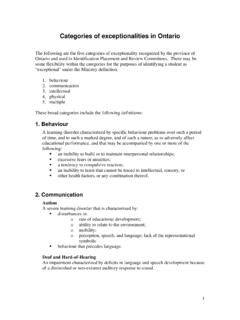Transcription of A Clinician’s Guide to Low Intensity Psychological ...
1 A Clinician s Guide to Low Intensity Psychological Interventions (LIPIs) for Anxiety and Depression29th April 2020by WA Primary Health AlliancePeter McEvoy1,2, Ebonnie Landwehr1, Caitlin Pearcy1, & Bruce Campbell21 School of Psychology, Curtin University2 Centre for Clinical Interventions, North Metropolitan Health ServiceMcEvoy, P., Landwehr, E., Pearcy, C., & Campbell, B. (2021). A clinician s Guide to low Intensity Psychological interventions (LIPIs) for anxiety and depression. Western Australian Primary Health Clinician s Guide to Low Intensity Psychological Interventions (LIPIs) for Anxiety and DepressionTable of ContentsA Clinicians Guide to Low Intensity Psychological Interventions (LIPIs) for Anxiety and Depression ..1 Table of Contents ..3 List of of Figures ..4 About this Manual ..5 Clinician Support ..5 Disclaimer ..5 Chapter 1 - An Introduction to Low Intensity Psychological Interventions (LIPIs).
2 6 Why Deliver LIPIs? ..6 The Use of CBT in LIPIs ..7 Factors Influencing Service Intensity ..8 Stepped Care ..10 Who Are LIPI Services Appropriate For? ..12 Summary ..12 Chapter 2 - LIPI Assessment and Problem formulation ..13 Essential Considerations ..13 Explain the Purpose and Structure of LIPI ..15 Adapting to Time Limits ..16 Outcome Measures ..16 Risk Assessment ..17 Problem Statements ..17 Simple LIPI Case formulation ..18 The Hot Cross Bun Model ..19 Example Interview Structure ..20 Example Interview Excerpts ..20 Summary ..32 Chapter 3 - Individual LIPI ..33 Sequence and Considerations for Individual LIPIs ..33 Psychological Tools and Techniques for LIPIs ..38 Example: Individual LIPI Assessment, formulation and Treatment Plan ..49 Summary ..52 Chapter 4 - Delivering LIPIs in Groups ..53 Designing the Group ..54 Example Group LIPI Session Planning.
3 57 Conducting the Group ..62 Summary ..65 References ..66 Appendix A - Outcome Monitoring Measures ..69 Appendix B - Linking Clinical Problems, Symptoms, Treatment Options And Resources ..77 Appendix C - Hot Cross Bun formulation Model ..80 Appendix D - Individual LIPI formulation And Treatment Plan ..81 Appendix E - Quick Guide To LIPI Assessment ..83 Appendix F - Group LIPI Design And Session Plan ..854WA Primary Health AllianceList of TablesTable : Features of Low Intensity Psychological Interventions (LIPIs) ..7 Table : Features of Higher and Lower Intensity Interventions ..8 Table : Advantages and Disadvantages of LIPI Modalities ..11 Table : SMART Goals ..39 Table : Example Safety Behaviours and Their Impact on Maintaining Clinical Problems ..48 List of FiguresFigure : Basic CBT Hot Cross Bun Model ..19 Figure : Dave s CBT formulation ..22 Figure : Katie s CBT formulation .
4 24 Figure : Tony s CBT formulation ..27 Figure : Janet s CBT formulation ..29 Figure : Decision Tree for Implementing LIPIs ..34 Figure : Dave s K10 Scores During Treatment ..37 Figure : Pros and Cons Table Case Example for Janet ..40 Figure : Stages of Change model ..41 Figure : Depression Group PHQ-9 Scores ..645A Clinician s Guide to Low Intensity Psychological Interventions (LIPIs) for Anxiety and DepressionAbout this ManualLow Intensity Psychological Interventions (LIPIs) can help to optimise a service s ability to match treatments to clients needs, thereby efficiently and effectively providing the right care at the right time to the largest number of people. This manual provides clinicians with the information they need to implement LIPIs for adults with anxiety and 1 describes different types of LIPIs that services may wish to consider using with their clients, along with some guidance about how to match LIPIs to clients needs.
5 Chapter 2 presents more detail about completing a LIPI assessment and case formulation , along with a case formulation template and case examples for several clinical problems. Chapter 3 illustrates how clinicians can use their case formulations to implement targeted Psychological tools and techniques within a LIPI. Case examples, a treatment planning template, and an example treatment plan are provided. Finally, Chapter 4 provides guidance on designing group LIPIs, which may be helpful when clinicians receive regular referrals for similar problems. A template for planning and designing a group LIPI is provided, along with case conjunction with appropriate supervision, this manual should provide clinicians with a range of skills needed to plan and implement LIPIs from a cognitive behavioural manual should be read in conjunction with the following documents:PNH Primary Mental Health Care Flexible Funding Pool Programme Guidance: Low Intensity Mental Health Services for Early Intervention (2019).
6 PHN Primary Mental Health Care Flexible Funding Pool Programme Guidance: Stepped Care (2019).PNH Primary Mental Health Care Flexible Funding Pool Programme Guidance: Consumer and Carer Engagement and Support For assistance with developing a LIPI for your service, contact Senior Clinical Psychologist and Research Director, Centre for Clinical Interventions, Curtin University, Professor Peter McEvoy information set out in this document (the Manual) is current as at 29th April 2020 and is provided to assist people (Users) who provide low Intensity Psychological interventions to adults with anxiety and/or depression. The Manual is to be considered as an adjunct to a User s training, expertise and knowledge and is not to be taken as being exhaustive on the subject matter or being a replacement to appropriate training, skills, experience or clinical supervision or governance for Users delivering Psychological of the Manual must exercise their own independent skill and judgement or seek appropriate professional advice relevant to their own circumstances when doing User cannot, by following any guidance, recommendations, processes or templates contained within the Manual, assume that this will discharge the duty of care owed by them (and any organisation from which or for whom they work, as an employee or contractor) to any person to whom they assist or deliver low Intensity Psychological interventions to.
7 Whilst the Manual is directed to health professionals possessing appropriate qualifications and skills in ascertaining and discharging their professional (including legal) duties, it is not to be regarded as clinical advice and, in particular, is no substitute for a full examination and consideration of medical history in reaching a diagnosis and treatment based on accepted clinical the full extent permitted by law, the WA Primary Health Alliance, Curtin University and the North Metropolitan Health Service including their officers, employees and agents make no warranty regarding the information, accuracy or completeness of the information in the Manual, and shall have no liability (including without limitation liability by reason of negligence) to, and are released and indemnified by, any Users of the information contained in the Manual for any loss or damage (direct, indirect, consequential or otherwise), cost or expense incurred or arising by reason of any User using or relying on the information contained in the Manual whether caused by reason of any error, negligent act, omission or misrepresentation in the a broken hyperlink by emailing Primary Health AllianceChapter 1 An Introduction to Low Intensity Psychological Interventions (LIPIs)Anxiety and depressive disorders are highly prevalent, with an estimated (264 million) and (322 million) of the global population experiencing these disorders, respectively (World Health Organization, 2017).
8 Moreover, the prevalence of anxiety and depressive disorders increased by and between 2005 and 2015 (WHO, 2017). Depression and anxiety disorders also increase the risks for additional physical and mental health problems that adversely affect functioning and quality of life (Anderson, Freedland, Clouse, & Lustman, 2001; Barger & Sydeman, 2005; WHO, 2017). Despite these significant impacts, many people do not seek treatment due to a range of barriers to accessing effective, evidence-supported treatments. Evidence-supported Low Intensity Psychological Interventions (LIPIs) based on the principles of cognitive behavioural therapy (CBT) are designed to support people with mental health problems of mild to moderate severity. Importantly, LIPIs can help to address a range of barriers to treatment, including clinician shortage, long wait-lists, cost of services to the consumer, stigma, transportation issues, and the need for child care (Haarhoff & Williams, 2017; Renton et al.)
9 , 2014; Shim, Mahaffey, Bleidistel, & Gonzalez, 2017).Why Deliver LIPIs?The primary aim of LIPIs is to increase community access to evidence-based treatments using the minimum amount of resources required to achieve optimal client outcomes. More intensive interventions should be offered to consumers with disorders of greater severity, so that interventions are matched to client needs. The features of LIPIs are described in Table (Australian Government Department of Health; Bennett-Levy et al., 2010, p. 8-9).7A Clinician s Guide to Low Intensity Psychological Interventions (LIPIs) for Anxiety and DepressionTable Features of Low Intensity Psychological Interventions (LIPIs)Ta r g e te dLIPIs are targeted to people with lower Intensity mental health are brief and structured interventions designed to provide an efficient and cost-effective alternative to more costly mental health services where these are not needed.
10 The structured nature of LIPIs can facilitate treatment are evidence-based for the presenting clinical accessibleLIPIs are designed to be easily and rapidly accessed by consumers when required, with or without a referral, although a general practitioner should be involved in health care. The frequency and volume of services should match consumers are delivered in a variety of formats to best suit the client s needs and preferences, as well as health service by a broad workforceLIPIs are delivered by suitably qualified health professionals for the level of service being provided. LIPIs are not typically delivered by specialist mental health professionals, but are instead provided by generalist are designed to address the needs of the area within which they are provided, particularly underserviced are designed to promote recovery, and may provide links to other services to match consumers to promote copingLIPIs are designed to help consumers to develop confidence in their own ability to manage their mental health more effectively, with support from health services as required.



